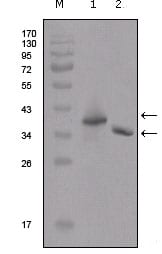
| WB | 1/500-1/1000 | Tag |
| IF | 1/20 | Tag |
| IHC | 1/100 - 1/1000 | Tag |
| ICC | 1/100-1/200 | Tag |
| FCM | 1/200 - 1/400 | Tag |
| Elisa | 1/10000 | Tag |
| clone | 2F11G1 |
| Host/Isotype | Mouse IgG2b |
| Antibody Type | Tag Antibody |
| Storage | Store at 4°C short term. Aliquot and store at -20°C long term. Avoid freeze/thaw cycles. |
| Species Reactivity | Tag |
| Immunogen | Synthetic peptide corresponding to aa(DYKDDDDK), conjugated to KLH. |
| Formulation | Purified antibody in PBS with 0.05% sodium azide. |
+ +
以下是3篇与Flag Tag抗体相关的代表性文献(信息基于公开学术资料整理,可能存在简化):
1. **"The FLAG peptide, a versatile fusion tag for the purification of recombinant proteins"**
- 作者:Einhauer, A., & Jungbauer, A.
- 摘要:综述了FLAG标签的设计原理,其对应抗体的高亲和力与特异性,以及在重组蛋白纯化(如免疫亲和层析)、Western blot和免疫沉淀中的应用优势。
2. **"Epitope tagging: monoclonal antibodies specific for tag sequences enable rapid protein characterization"**
- 作者:Prickett, K.S., et al.
- 摘要:比较了FLAG、HA、Myc等标签抗体的性能,指出FLAG抗体(如M1/M2系列)在低背景信号和哺乳动物细胞表达系统中的高特异性,适用于活细胞表面蛋白检测。
3. **"A vector for expression of proteins with an N-terminal FLAG epitope in mammalian cells"**
- 作者:Chubet, R.G., & Berd, G.
- 摘要:描述了含FLAG标签的哺乳动物表达载体构建,验证其配套抗体在流式细胞术和免疫荧光中的高效检测能力,强调标签的小分子量对目标蛋白干扰小的特点。
4. **"Overview of tag protein fusions: from molecular and biochemical fundamentals to commercial systems"**
- 作者:Terpe, K.
- 摘要:系统分析了FLAG与其他标签(如His、GST)的优缺点,指出FLAG抗体纯化的洗脱条件温和(依赖钙螯合剂),可保持目标蛋白活性,但成本高于His标签体系。
注:实际文献检索建议通过PubMed或Web of Science以“FLAG tag antibody”、“M1/M2 monoclonal antibody”、“epitope tagging applications”为关键词查询最新研究。
Flag Tag antibodies are widely used tools in molecular and cellular biology for detecting, purifying, and characterizing recombinant proteins. The Flag Tag, a short hydrophilic peptide sequence (DYKDDDDK), was first developed in the late 1980s as an epitope tag. Its design prioritizes minimal interference with protein folding or function while enabling specific recognition by corresponding antibodies. The tag’s small size (8 amino acids) and charged nature reduce steric hindrance, making it suitable for diverse applications, including Western blotting, immunoprecipitation, immunofluorescence, and protein localization studies.
Anti-Flag antibodies exhibit high specificity and affinity, primarily targeting the conserved N-terminal (DYKDDDK) or internal regions of the tag. Monoclonal antibodies like M1. M2. and M5 are commonly used, with M2 (mouse-derived) being the most popular due to its calcium-independent binding, enabling versatile experimental conditions. These antibodies are often coupled to agarose beads for affinity purification or conjugated to fluorophores/enzymes for detection. Commercial kits and engineered expression vectors (e.g., pFLAG plasmids) have standardized its use, enhancing reproducibility.
The Flag system’s compatibility with other tags (e.g., HA, Myc) allows multiplex protein analysis. However, occasional non-specific binding requires optimization of blocking buffers and controls. Despite newer tagging systems emerging, the Flag Tag remains a gold standard for its reliability and extensive validation in both prokaryotic and eukaryotic systems. Its applications span basic research, drug development, and biotechnology, underscoring its enduring utility in protein science.
×